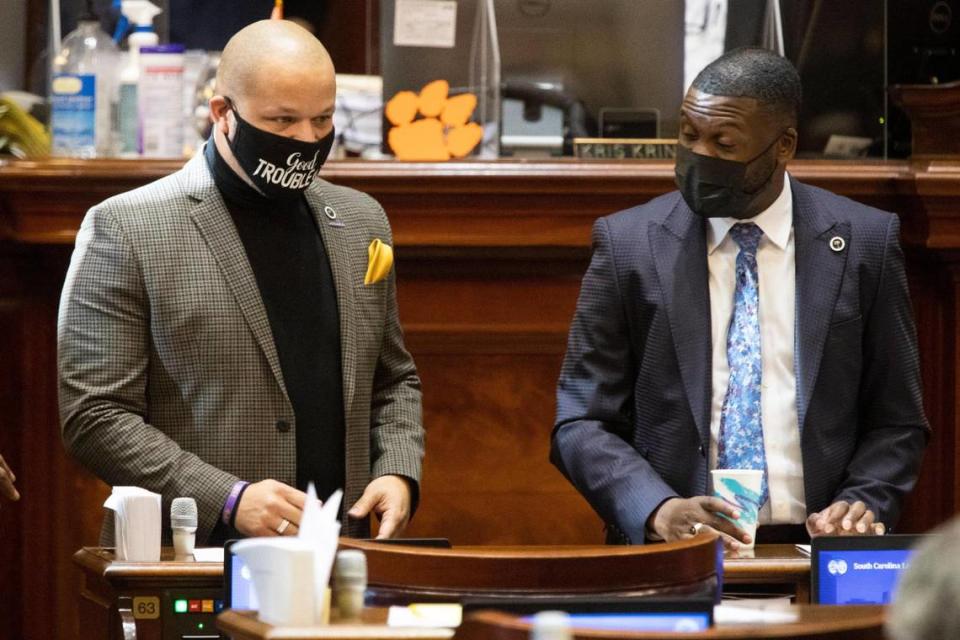Huge SC growth along Rock Hill border with NC gives York County another House seat
York County will get another seat in the South Carolina House under a new redistricting map adopted Thursday by the lower chamber.
The plan, which has been criticized for favoring Republicans and incumbent politicians at the expense of voters, passed 96-14. It requires a final vote Monday and must then be adopted by the Senate, but those steps are considered perfunctory.
The House map, released early last month and amended in committee, is projected to give Republicans a supermajority in the House and could significantly reduce the number of competitive districts in the state. The current political makeup of the chamber is 81 Republicans to 43 Democrats. Based on returns from the 2020 presidential election, South Carolina’s voters are 55 percent Republican, 43 percent Democrat and roughly 1.5% third party.
Due to South Carolina’s explosive growth over the past decade — the state added about 500,000 people, according to the 2020 census — large-scale changes were necessary to ensure all districts had roughly the same number of people.
Under the proposal, Charleston, Horry and York — three of the fastest growing counties in the state — would add seats taken from areas where population has increased more modestly or not at all since 2010. Richland County, on the other hand, is due to lose a seat after the merger of two lower Richland districts.
District 66, which moved from Orangeburg to York County to accommodate the area’s population growth, will absorb the portion of state Rep. Raye Felder’s current district west of Interstate 77, including Tega Cay, but not crossing Lake Wylie.
“We’ve had tremendous growth in northern York County and northern Lancaster County. I mean, the census numbers just blew up,” Felder, R-York, said. “So in looking at that amount of tremendous growth, there was really no other way but to add a new district up there.”
Felder’s District 26 will now run east of I-77 to the Lancaster County line, and together the districts will comprise all of York County north of the Catawba River.
“York County is very similar all over, but especially north of the Catawba River,” she said. “We are geographically incredibly similar, and also in our lifestyle and our quality of life because we are next door to Charlotte.”
The new York County seat is open, with no incumbent living in the district.
Felder said she was thankful the committee had taken her input about maintaining districts within county lines, using natural barriers — like a river or an interstate — to divide districts and keeping communities of interest together
“Try not to split cities, try not to split townships. I think all of that builds to better government, where it’s possible to do,” she said.
State Rep. John King, D-York, expressed reservations about the House map during committee hearings, including what he said was its failure to safeguard minority districts, but ultimately voted in favor of the map.
Last month, he introduced three amendments to the map, but only one was adopted. King’s amendment that was adopted dealt with the dividing line between his district and a neighboring district that he said would enhance the ability of minority groups in the area to elect candidates of their choice.

While the once-a-decade redistricting process is nearly always fraught with conflict and accusations of partisan bias, critics say the House map is particularly egregious — a sign the map may be challenged in court.
The state’s underlying demographics make creating a truly unbiased map impossible, but the new House map is significantly more gerrymandered than even the existing imperfect map, an impartial analysis indicates.
Only nine of 124 districts are competitive, or about half as many as the current House map, according to Dave’s Redistricting app, a popular map drawing and analysis tool.
“The extremely low number of competitive districts — even at a generous ±5% standard — points toward making voters nearly obsolete in general elections for the SC House of Representatives,” the nonpartisan League of Women Voters of South Carolina wrote in its assessment of the proposal.
State Rep. Jay Jordan, R-Florence, who chaired the House redistricting committee, defended the integrity of the panel’s process, saying it had gone to great lengths to ensure everything was done transparently.
“Incumbent locations were considered,” he said. “But lines were not contorted in order to protect incumbent legislators. I can say that very, very clearly.”
The House map splits roughly the same number of counties as the current one, but nearly three times as many precincts, which can create voter confusion. It has 32 majority-minority districts — two more than the current map — but actually scores lower on minority representation, according to Dave’s Redistricting.
Ten incumbents — four Republicans and six Democrats — are drawn into districts with one another, setting up potential primaries next year, and at least two districts are left without an incumbent after their representative was shifted into a neighboring district.
House lawmakers who have been drawn into the same district are Reps. Vic Dabney, R-Kershaw, and Brandon Newton, R-Lancaster, in District 45; Reps. Jerry Govan, D-Orangeburg, and Russell Ott, D-Calhoun, in District 93; Reps. Cezar McKnight, D-Williamsburg, and Roger Kirby, D-Florence, in District 101; Reps. Sandy McGarry, R-Lancaster, and Richie Yow, R-Chesterfield, in District 53; and Reps. Wendy Brawley, D-Richland, and Jermaine Johnson, D-Richland, in District 70.
Of the incumbents who are “double bunked” in the new map, all but Newton, McKnight and Yow voted against the proposal or did not vote
McGarry, whose 2020 win was a boon for the South Carolina Republican Party, which flipped five State House seats to further expand the party’s majority, told The State Wednesday she did not plan to run against Yow, her political mentor.
“It’s hard going from that super win of 2020 to being thrown out of the House,” she said. “Because that’s what it feels like.”

 Yahoo Movies
Yahoo Movies 
